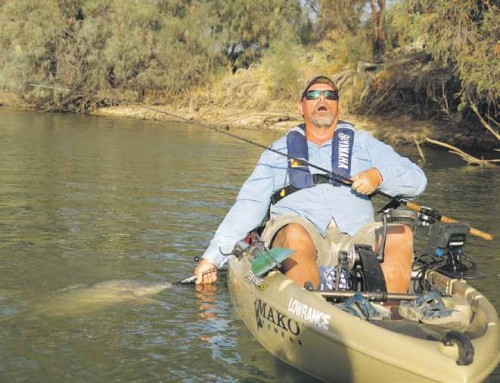 |
| Steve Starling is relieved that all went according to plan. |
Jo Starling shares some tips on fighting big fish from a kayak.
Presented from Issue 117, August 2015
The thought of fighting giants from a kayak is enough to raise the pulse of any angler—but you should never pick such a fight without a battle plan. No matter what critters you choose to chase, Jo Starling reckons this strategy will give you a fighting chance. Recently, Steve and I embarked on a journey across western NSW and South Australia with the sole purpose of landing a goliath Murray cod from a kayak. We run a couple of Native Watercraft models and really wanted to test the Propel® units’ reverse capabilities against a hefty structure magnet. Whilst not everyone chooses the same ‘yak, the prior planning and preparation that went into this trip is relevant to anyone hoping to mix it with worthy adversaries in structure. For the record, the Propel® unit brained it… let me tell you the story.
Having not confronted a genuinely powerful fish in tight waters from a kayak before, we knew we would be fools to take a win for granted. As the anecdote states: “Prior preparation and planning prevents poor performance”. So it was that for a month or so leading up to our departure date, our lunch time musings turned to how we might parry the instincts of a burley cod if, indeed, we managed to find one.
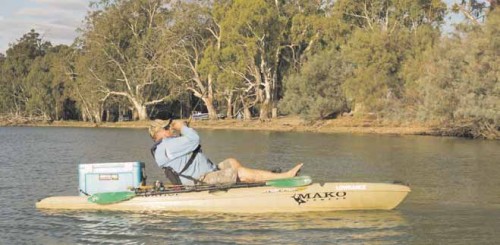 |
| The backwards momentum of the Native Watercraft was used to good effect in this tussle, however strategic use of your kayak position will help if your kayak doesn’t have this capability. |
We believed that we had an advantage over many other ‘yakkers, given that our boats had reverse capability, but pulling backwards on a big fish isn’t always going to be the answer, and so we devised a plan of attack that took all conceivable contingencies into account.
Here’s what we knew about the challenges we would face: A big cod, if hooked, would likely run back to its snag; it would have the power to tow our kayak; and, it would be lightning fast. Clearly, these same factors are relevant to any structure dwelling fish, whether in salt or fresh, so it stands to reason that the battle plan we developed will suit, regardless of whether you’re chasing a cod, a big barra (please consider carefully which waterways you chase barramundi on… most often, barra and crocs go hand-in-hand), a mulloway, a mangrove jack or a snapper. In fact, even big blue-nosed bream dwelling in snags or oyster leases present similar issues.
Planning for battle
The best strategy is to go into every cast ready to fight a fish. How you do this will vary slightly depending on the model of kayak you run, but there are some key points that hold true for all ‘yak battles. Your priority should be identifying which are your best “exits”, that is, which way are you best heading once you’ve struck your fish. Think about this before you make your cast. If the fish is there and picks up your gauntlet, you may not have time to think about it afterwards.
The actual choreography of your fishy fight will come down to the style of kayak you have. Nowadays, many kayak anglers opt for pedal-propelled kayaks to keep their hands free for fishing. This has enormous benefits when you’re hooked up, as you can put powered pressure on the fish without compromising your rod work. Paddle-powered kayaks have been around a lot longer, however, and the basic battle plan to fight a fish from any ‘yak was developed long before the first pedals hit the water.
Power of persuasion
Obviously, you can’t afford to put your rod down to pick up your paddle once you’re on a fish. If you are in a paddle-only kayak, your success if going to come down to the direction you face your kayak in relation to your rod angle and the fish. You will not have the capacity to drive away from the structure, so you will need to persuade the fish to swim away from it instead. The first thing to realise is that even a fairly modest fish can easily tow you if your kayak is pointing towards it. For this reason, try to position your kayak perpendicular to your cast. That way, if the big fish strikes and runs, it has to drag your full hull length against the water… that’ll slow it up a bit!
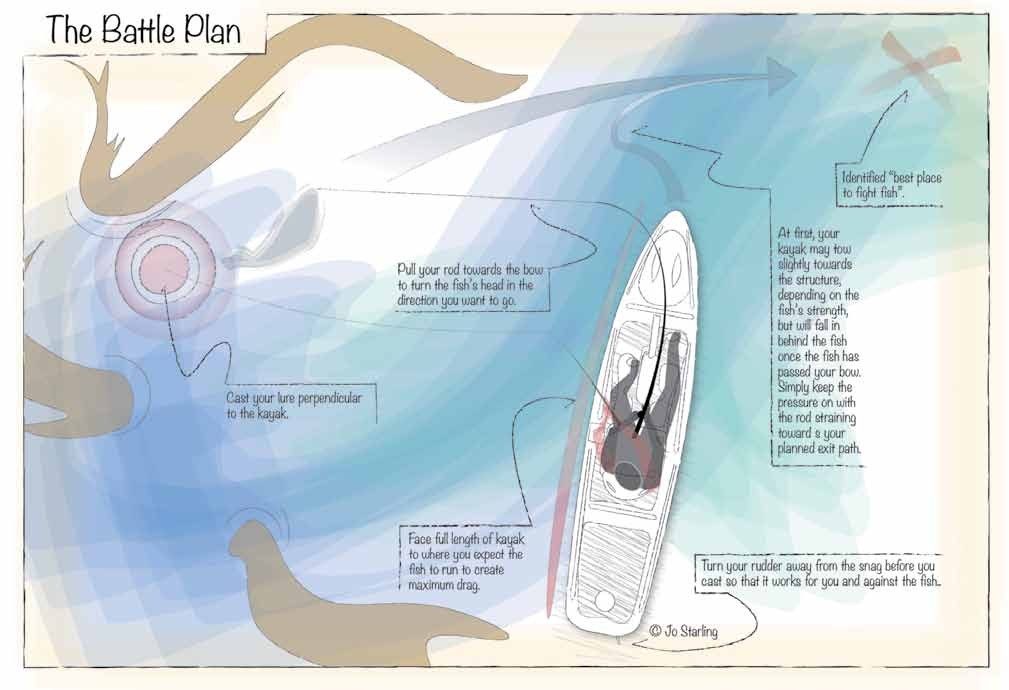 |
| The Battle Plan - click for a larger image |
Your next challenge will be to get the monster away from the structure. Remember that planned exit route? If you firmly and smoothly pull your rod around to point in that direction, you should be able to steer the fish that way. As you pull against the fish, your kayak will inevitably start to turn back towards it. Don’t stress. As the fish turns towards the kayak, the pressure will lessen (don’t allow slack!). The fish should instinctively head in the direction of less resistance. If all goes well, the fish will soon be heading out and your kayak will fall in behind it, an easy tow now that your bow and rod are in line with your quarry. Once you are happy that the fish is clear of structure, you can once again turn the bow across the fish’s path to apply pressure.
How? Simply pull the rod around to your side to change your position in relation to the fish. Once your kayak is in its “braking” position, you can fight the fish on the rod. Naturally, if the fish manages to run towards more structure, you need to steer it out again and let it run clear.
It’s not a bad idea to practice some of these manoeuvres on a snag rather than waiting to test our theories in the heat of battle.
Pedal to the metal
Even though we mounted our cod attack aboard pedalled kayaks, these tactics still formed the crux of our battle plan. At every snag, we considered our best exit direction, set our rudder accordingly and then cast. Having the benefit of reverse meant that our first response would be to pedal backwards, however, those of you fishing from other pedalled craft without a reverse function will still need a forward motion action plan. Side on to the cast with a pre-set rudder is your best bet, too.
“So,” I hear you asking yourself… “Did the planning pay off?”
I’m not going to say it was easy. Truth be known, Steve and I would have put in over a thousand casts apiece and two full days on the water without so much as a suggestion that cod lived in the Murray River. The important thing is that we stuck to our game plan. As we hit the water on day three, our determination levels were at fever pitch and the weather forecast had changed, meaning that this was likely to be our last chance. A massive rain front had formed over the Bight and was heading our way. We’d had a major hiccough through the day that had held us off the water until 4pm. The shadows were already drawing long and the sun’s intensity was failing. Perhaps the sudden change in conditions would influence a change in fortunes as well? Fingers were crossed.
I’d really like to report that it was I who landed the leviathan… but it was not. It was Steve, third cast on the first snag of that shortened fishing session who hit paydirt. We knew immediately that it was the test we’d been hoping for. Moments after the rod jolted and sent a shock through Steve’s palms, the keg-like cod was around one submerged snag and over another one beyond that.
Being a newbie in the Native Watercraft, all our well-fashioned plans fled Steve’s mind as the adrenalin pumped through his temples and his long-forged fishing instincts took over. I recall him leaning back hard against his rod and commentating the whole fight… “Dammit! It’s bricked me! It’s found the timber!” he’s calling out to me as I’m getting my spinnerbait out of the way. What he wasn’t doing amongst all this commotion was employing his strongest weapon. “PEDAL BACKWARDS!” I ordered from the sidelines.
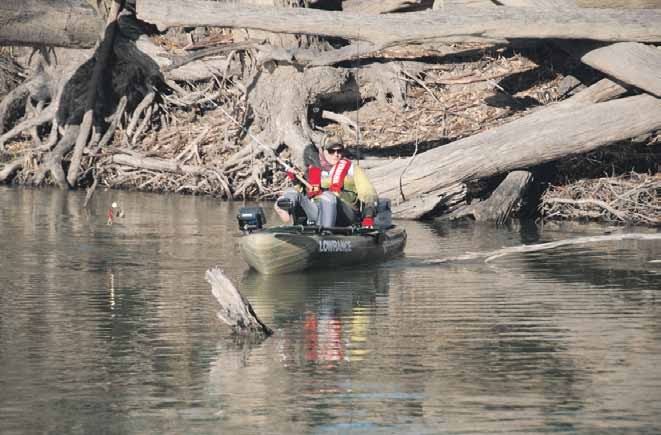 |
| Planning your best exit and positioning your kayak for battle before casting is good practice. |
Sure enough, the kayak was able to pull the fish back over that deeper snag. Steve then pedalled forward, winding up slack desperately as he powered over the top of the other submerged branch to undo half of the wrap. With a fair bit of experience on his side, he was able to rescue the situation and, before long, had successfully persuaded the fish to head out into the open. Boy oh boy! It was an exciting event to watch! The satisfaction of the plan coming together was shared by both of us and it’s certainly a fishing outing neither of us will ever forget.
The winners’ salute
Of course, hooking such a fish and manoeuvring it clear of structure is only part of the quest. At some stage, you must either win or lose any fight you engage in. So what do you do when you’re in deep water, in a capsizeable kayak, attached to a fish that weighs nearly as much as your ‘yak?
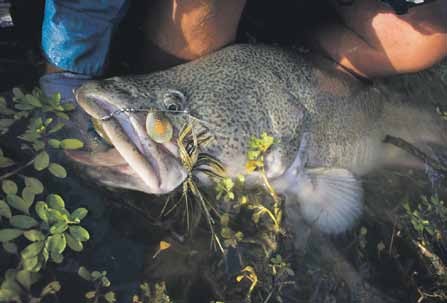 |
| A joyous capture and an even more joyous release… This immaculate Murray cod put up a monumental fight. It shows big fish can be kayak caught in trying conditions. |
This is another situation you need to plan for. Luckily, we had. You’ll fashion a plan depending on the species you are targeting, but for us it was about getting the fish safely back to shallows for some photos and a measure before safe release back to the timber. We knew we couldn’t hope to use our esky-live wells, so we each had strong lip grips with wrist straps purely for tethering the fish securely and swimming it beside the kayak as we pedalling back to the bank of the river.
Different objectives and circumstances will call for different solutions. The point is, you need to think about this part of your battle if you have any hope of pumping your fist in the air in a victory salute.
Incidentally, Steve’s cod measured 103cm and would’ve weighed almost 25kg—a most majestic creature and a worthy test for both the kayaks’ and our capabilities. I just wish it had have been me trembling with the adrenalin rush… Oh well, all the more reason to keep going back. Like I needed the excuse!
Photography by Jo Starling and John Haenke (Fishing Downunder)
